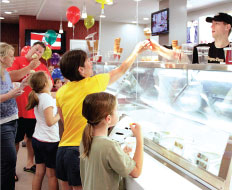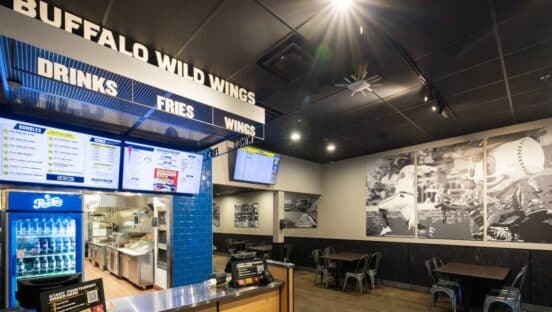Everyone loves a party, especially when it’s hosted by their favorite restaurant brand. With in-store events, quick-service and fast-casual brands from every corner of the industry can drive traffic into stores, while also ensuring future revenue increases and guest loyalty by letting customers in on free or discounted products.
“When you host an event, you are giving people a reason to come to your restaurant instead of just waiting for them to walk through your doors,” says Debra Vilchis, chief operating officer of Fishman PR and Marketing. Her public relations firm represents quick serves like Arby’s, Moe’s Southwest Grill, and Auntie Anne’s.
“Inviting people to your restaurant increases the chances of them coming by because you are being proactive instead of reactive” in the attempt to attract guests, she says.
The proactive mindset led Capriotti’s Sandwich Shop to launch events in its stores during the evening daypart, which has historically seen less traffic.
“Since our stores do less business during dinner, we hold kids’ events in the evening to turn a slower time segment into a higher-performing one,” says Ashley Morris, CEO of the sandwich chain. He says this not only drives unexpected revenue for individual units, but also avoids overloading employees and managers during a peak time.
Ice cream concept Häagen-Dazs also uses this strategy by encouraging its franchisees to hold community fundraising events—like its annual Free Cone Day—in the stores on Monday and Tuesday evenings, says the brand’s marketing manager Justin Chafe.
Many brands hope the increased traffic they bring in with events is made up of several new customers. Vilchis says delivering excellent customer service and providing high-quality food during an event or fundraising night are two ways to guarantee that those new customers choose to come back again during regular business hours.
Operators could also provide discounts, coupons, or incentives to give attendees a reason to return. She adds that stores should have enough staff working during the event in case of high turnout, and employees should be thoroughly trained on event specifics.
To help in-store events run more smoothly, it’s beneficial for a brand’s corporate team to create guidelines and marketing materials for approved events, and then give franchisees the freedom to adapt the celebration to their local culture, Häagen-Dazs’s Chafe says.
“For our community school fundraising nights, we give our stores the tools they need to successfully host the event,” he says. “We see our franchisees as inherently local, and they need to be involved and engaged with their community. Events are a great way to do this.”
By preplanning events for franchisees, Häagen-Dazs encourages celebrations but also ensures that they fall within the concept’s overall branding, he says.
“The type and theme of your events should relate to your brand so that the event works to create a consistent message in the consumer’s mind,” Vilchis says. “You want people to walk away remembering your restaurant, your food, and your concept. If your event is not related to your brand, then you run the risk of disassociating the event in your customer’s mind from the brand.”
Successful events can feature a range of themes and target demographics, from kids’ nights to special parties or fundraisers.
These celebrations can give brands and operators access to certain customer segments and audiences they’ve been itching to tap into, Vilchis says. “When you host regular events, people get used to coming back to your restaurant on a regular night,” she says. “Your restaurant can then become a new gathering place and even a tradition.”
Because many customers have busy schedules, brands must also plan events in a manner that offers target customers an incentive to take the time out of their day to attend, such as a discount geared toward that audience.
Another successful event strategy is to provide attendees with entertainment, such as an appearance by a local celebrity or live music, Vilchis says.
But no matter the thought and planning that go into creating and executing a successful event, the effort won’t pay off if customers don’t know about it. Three to four weeks before the event, Vilchis says, operators should begin marketing through social media and e-mail newsletters.
“Carefully word your promotion to position it as an event,” Capriotti’s Morris adds. “It took us several tries to get the proper wording so that customers saw it as an event instead of just free kids’
meals.”
Social media gives people the ability to share the details of an upcoming event with friends who may be interested in attending, Chafe says.
“We found that 40–50 percent of the people who came out to the event found out about Free Cone Day on Facebook,” he says. “During the four hours of the event, we had over a million people talking about Free Cone Day on social media.”
But Vilchis also warns quick serves to avoid becoming so focused on social media and other flashy marketing efforts that they forget about one of the most tried-and-true event marketing techniques: the flier.
“Hanging up good old-fashioned fliers both in the store and in the community can be surprisingly effective,” she says. “Sending home fliers in the backpacks of local school children can also be a great way to get the word out.”
Brands can even encourage their employees to engage with customers at the the point of sale, drive-thru window, or on the floor to personally invite them to the event, she says.
Morris says it’s important for operators to take some time to debrief with their staff after an event in order to discus success and challenges of the event. They can then apply these lessons to future events.
“The more types of events that you can do within your community that are community-based give your brand a more loyal customer in the end,” he says. “The small cost of the event gives you the benefit of being involved in the community.”












